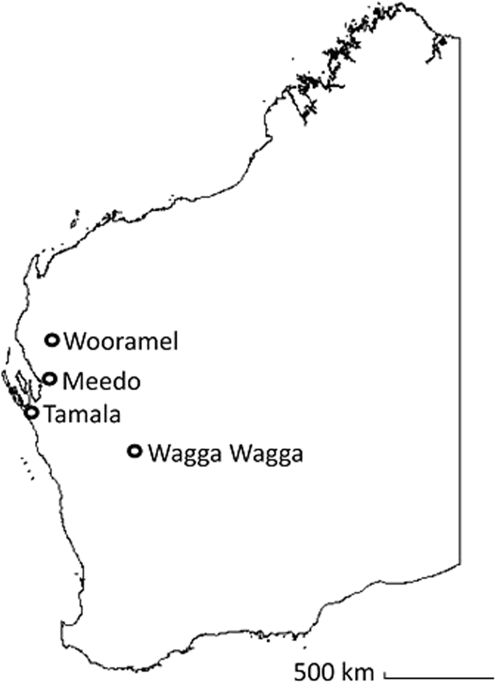Our official English website, www.x-mol.net, welcomes your feedback! (Note: you will need to create a separate account there.)
Salmonella enterica isolates from Western Australian rangeland goats remain susceptible to critically important antimicrobials.
Scientific Reports ( IF 4.6 ) Pub Date : 2018-Oct-17 , DOI: 10.1038/s41598-018-33220-5 Khalid Al-Habsi 1 , David Jordan 2 , Ali Harb 1 , Tanya Laird 1 , Rongchang Yang 1 , Mark O'Dea 1 , Caroline Jacobson 1 , David W Miller 1 , Una Ryan 1 , Sam Abraham 1
Scientific Reports ( IF 4.6 ) Pub Date : 2018-Oct-17 , DOI: 10.1038/s41598-018-33220-5 Khalid Al-Habsi 1 , David Jordan 2 , Ali Harb 1 , Tanya Laird 1 , Rongchang Yang 1 , Mark O'Dea 1 , Caroline Jacobson 1 , David W Miller 1 , Una Ryan 1 , Sam Abraham 1
Affiliation

|
This study investigated faecal carriage and antimicrobial resistance (AMR) of Salmonella enterica recovered from rangeland goats. Faecal samples (n = 400) were collected at slaughter from four consignments of goats (n = 100 samples per consignment), each from one of four localities in Western Australia. Carriage of Salmonella spp. was detected in 106 samples (26.5%; 95% CI 22.4-31.0%). The rate of faecal carriage for each consignment ranged between 23-30%. PCR assays targeting the STM2755 and STM4497 genes revealed 84.9% (90/106) of the isolates were of serovar Typhimurium. Salmonella Chester (11/106, 10.4%) and S. Saintpaul (5/106, 4.7%) were characterised at invA and ompF genes. Antimicrobial susceptibility testing demonstrated that 84.0% of isolates were susceptible to all tested (n = 13) antimicrobials. Resistance was identified to azithromycin (14.2%), tetracycline (10.4%), ampicillin (5.7%), amoxicillin-clavulanate and cefoxitin (3.8%), trimethoprim/sulfamethoxazole (1.9%), gentamicin and streptomycin (0.9%). No isolate was resistant to four or more antimicrobials, or to critically important antimicrobials such as fluoroquinolones and extended spectrum cephalosporins. This is the first study reporting AMR in Salmonella isolates from Australian rangeland goats. The rate of detection of AMR was very low, some resistance to low-importance drugs was present in the Salmonella population, despite the absence of active selection pressure.
中文翻译:

从西澳大利亚牧场山羊中分离出来的肠道沙门氏菌仍然对极其重要的抗菌药物敏感。
本研究调查了从牧场山羊身上回收的肠道沙门氏菌的粪便携带和抗菌素耐药性 (AMR)。在屠宰时从四批山羊(每批 100 个样本)中采集粪便样本(n = 400),每批山羊来自西澳大利亚四个地点之一。沙门氏菌的携带 在 106 个样本中检测到 (26.5%; 95% CI 22.4-31.0%)。每批货物的粪便携带率在 23-30% 之间。针对 STM2755 和 STM4497 基因的 PCR 检测显示,84.9% (90/106) 的分离株属于鼠伤寒血清型。Chester 沙门氏菌 (11/106, 10.4%) 和 Saintpaul 沙门氏菌 (5/106, 4.7%) 的 invA 和 ompF 基因进行了表征。抗菌药物敏感性测试表明,84.0% 的分离株对所有测试的 (n = 13) 抗菌药物敏感。已确定对阿奇霉素(14.2%)、四环素(10.4%)、氨苄西林(5.7%)、阿莫西林克拉维酸和头孢西丁(3.8%)、甲氧苄啶/磺胺甲恶唑(1.9%)、庆大霉素和链霉素(0.9%)耐药。没有分离株对四种或更多抗菌药物或极其重要的抗菌药物(例如氟喹诺酮类和广谱头孢菌素)具有耐药性。这是第一项报告澳大利亚牧场山羊沙门氏菌分离物中 AMR 的研究。尽管不存在主动选择压力,但 AMR 的检测率非常低,沙门氏菌群体中仍存在对低重要性药物的一些耐药性。
更新日期:2018-10-17
中文翻译:

从西澳大利亚牧场山羊中分离出来的肠道沙门氏菌仍然对极其重要的抗菌药物敏感。
本研究调查了从牧场山羊身上回收的肠道沙门氏菌的粪便携带和抗菌素耐药性 (AMR)。在屠宰时从四批山羊(每批 100 个样本)中采集粪便样本(n = 400),每批山羊来自西澳大利亚四个地点之一。沙门氏菌的携带 在 106 个样本中检测到 (26.5%; 95% CI 22.4-31.0%)。每批货物的粪便携带率在 23-30% 之间。针对 STM2755 和 STM4497 基因的 PCR 检测显示,84.9% (90/106) 的分离株属于鼠伤寒血清型。Chester 沙门氏菌 (11/106, 10.4%) 和 Saintpaul 沙门氏菌 (5/106, 4.7%) 的 invA 和 ompF 基因进行了表征。抗菌药物敏感性测试表明,84.0% 的分离株对所有测试的 (n = 13) 抗菌药物敏感。已确定对阿奇霉素(14.2%)、四环素(10.4%)、氨苄西林(5.7%)、阿莫西林克拉维酸和头孢西丁(3.8%)、甲氧苄啶/磺胺甲恶唑(1.9%)、庆大霉素和链霉素(0.9%)耐药。没有分离株对四种或更多抗菌药物或极其重要的抗菌药物(例如氟喹诺酮类和广谱头孢菌素)具有耐药性。这是第一项报告澳大利亚牧场山羊沙门氏菌分离物中 AMR 的研究。尽管不存在主动选择压力,但 AMR 的检测率非常低,沙门氏菌群体中仍存在对低重要性药物的一些耐药性。



























 京公网安备 11010802027423号
京公网安备 11010802027423号